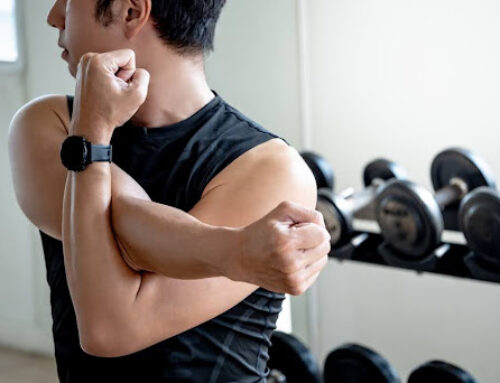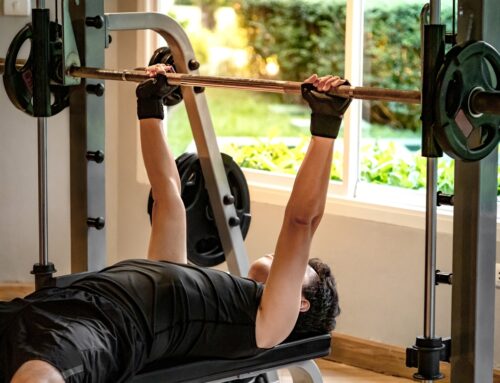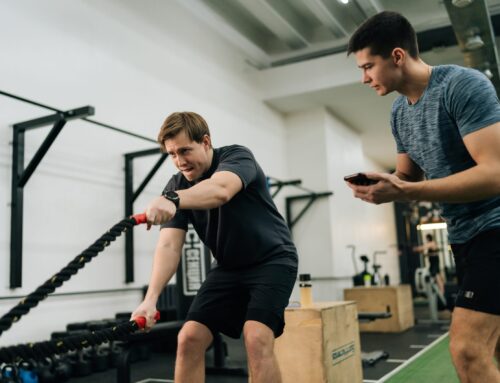If you ask most people about their fitness routine, it’s doubtful they’ll mention stretching. Most gym-goers focus on things that build muscle or promote fat loss, not considering just how much a stretching routine could benefit their workouts and everyday life.
Stretching is one of the most neglected parts of training. And for those who do take time to stretch, many either don’t do enough of it or are doing it wrong (if you are holding your stretches before your workout, we’re talking to you).
Perhaps you never miss a workout, nail your protein intake goals, push through cardio, sit in the sauna, or take a dip in a cold plunge. But if you aren’t including proper stretching as part of your fitness routine, you are missing out on a key component of your progress.
While it might not make you sweaty, get your heart rate up, or give you a pump, the right approach to stretching can make every rep, run, or fitness class not only safer and smoother but also more effective.
In this article, we’ll tell you why it’s so important, the difference between dynamic and static stretching, when and how each should be performed, and help you get started on building a stretching routine that fits your goals.
Why is Stretching Important for a Fitness Routine?
Think of stretching as maintenance work for your muscles and joints. Without it, everything will feel tighter, stiffer, and more prone to injury or breaking down over time.
When you stretch consistently, you improve how your body moves, recovers, and performs. Joints feel less restricted, muscles respond better under load, and the risk of nagging injuries goes down.
Of course, this is important for anyone who takes their workouts seriously. If you skip stretching as part of your warm-up and recovery, your body will eventually pay the price.
However, stretching is essential even for those who live more sedentary lifestyles, especially those who work at a computer all day.
Stretching provides full-body benefits that you can’t get any other way. Along with enhanced physical performance and more flexibility, stretching has many health benefits that extend outside of the gym, including:
- Improved balance and coordination
- Greater range of motion
- Reduced risk of injury
- Improved circulation
- Better posture
- Stress relief
Stretching may not deliver the instant feedback of a pump or the satisfaction of closing out those rings on your fitness tracker, but it’s crucial for training at your best, recovering faster, and moving well outside of the gym.
The Role of Stretching in a Well-Rounded Fitness Routine
A complete fitness plan isn’t only about strength training and cardio. A structured stretching routine ties everything together. Whether you’re trying out all the top fitness trends of 2025, focused on functional training, doing compound or isolation movements, or working out with your kids at home, stretching keeps your body balanced and capable of handling the demands you place on it.
Here are a few key roles stretching plays in building a strong, resilient, and well-rounded fitness program:
Enhances Flexibility and Range of Motion
Flexibility is your body’s ability to move through a full range without tightness or restriction. It’s what allows you to squat deeply, press overhead with proper form, or simply reach down to tie your shoes without strain.
Regular stretching keeps muscles long and joints moving smoothly, which protects your body both in the gym and in daily life. The more freely your body moves, the easier it becomes to train hard without compensating with poor mechanics.
Accelerates Recovery and Reduces Muscle Soreness
After a tough workout, your muscles need to shift into repair mode. Stretching helps restore blood flow to the muscles just worked, delivering oxygen and nutrients that accelerate the recovery process. Proper stretching also helps reduce delayed onset muscle soreness (DOMS), which is the stiffness and muscle pain you often feel a day or two after training.
Helps Prevent Injury
Cold, tight muscles are more likely to strain or tear under pressure. The right type of stretching before a workout prepares the body for movement by gradually increasing circulation and activating the muscles you’re about to use. After a workout, stretching helps muscles relax, reduces tension, and lowers the risk of lingering stiffness that can set you up for injury in later sessions.
The type of stretching you do before a workout differs from that done after a workout. Before training, you’ll want to do dynamic (movement) stretches. Afterwards, you’ll focus on static (holding) stretches. We’ll explain the difference between dynamic vs. static stretching and provide examples next.
Enhances Performance and Results
Stretching improves flexibility over time, which translates into better form and technique. Whether it’s hitting depth in a squat, locking out a deadlift, or running with an efficient stride, stretching makes your movements cleaner and safer, resulting in better overall performance. The more efficient your training is, the better your results will be.
Dynamic vs. Static: Knowing When to Stretch
Not all stretching is the same. The benefits you get depend on when and how you do it. Dynamic stretching is best before training, while static stretching should typically be reserved for post-workout recovery or non-training days.
Knowing the difference between dynamic and static stretching is important, as it helps you avoid common mistakes and maximize the benefits of your workout routine.
Dynamic Stretching: Your Pre-Workout Warm-Up
Dynamic stretches involve continuous, controlled movements that take your muscles and joints through a full range of motion. Instead of holding a pose, you’re moving similar to the movements you’ll be performing in your workout.
Dynamic stretching increases blood flow, raises your core temperature, and activates the muscle groups you’re about to use. This prepares your body to perform at a higher level and reduces the risk of pulling a cold, tight muscle.
For example, if you’re heading into a squat session, a dynamic warm-up could include:
- bodyweight squats
- hip circles
- walking lunges
These movements help to prepare the hips and slightly activate your quads and glutes. If you’re running, leg swings and high knees are perfect for loosening up the hamstrings and priming your stride.
The reason you don’t want to hold stretches before a workout is that static stretching relaxes the muscles at a time when you actually want them primed and ready to fire. Static long holds of over about 10 seconds are believed to temporarily decrease strength, speed, and power.
Static Stretching: The Post-Workout Cool-Down
Static stretches are held in place for 20 seconds or more. They focus on lengthening the muscle and allowing it to release tension. These are the stretches most people associate with stretching, such as:
- seated hamstring stretch
- quad stretch
- neck stretching
and yoga poses like:
- child’s pose
- butterfly stretch
- cobra pose
The goal of static stretching isn’t to get your body ready for strength training or explosive movement, but to help muscles relax, restore their length, and support long-term flexibility.
Doing this before training could actually decrease strength and power output, leaving your muscles less responsive to training.
Can I Do Static Stretches Before a Workout?
It depends on how long you hold the stretch. If it’s only a few seconds, that is generally okay. However, holding a stretch any longer isn’t a good idea, nor is it nearly as beneficial as dynamic stretching before a workout. You could end up reducing your power output and feel weaker going into your workout.
If you are taking the time to stretch, you want to perform the type of stretch that is most beneficial in that moment. If you want to prime your body before exercise, stick with dynamic movements that build heat and activate muscles, rather than slowing them down. Save static stretching for your warm-ups and rest days.
What Type of Stretching Should I Do on Non-Training Days?
Rest days are the perfect opportunity to get in a longer stretch session. Both dynamic and static stretching can be used on non-training days. You can mix static stretches with low-intensity dynamic movements, or even attend a yoga or Pilates class for a more structured approach.
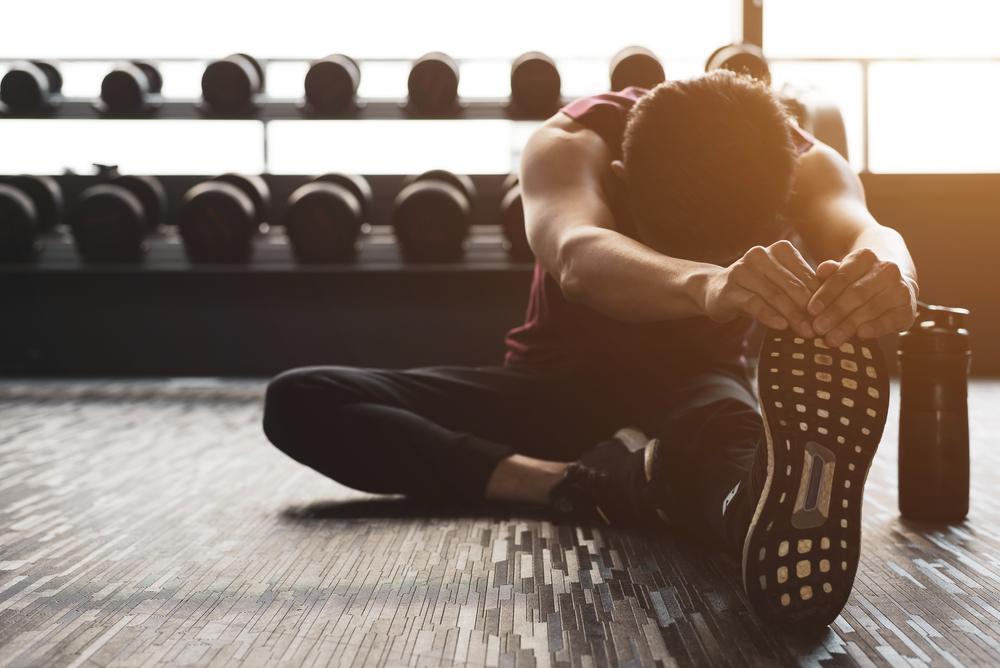
Stretching Routines for Different Goals
Not every stretching routine looks the same. The best approach depends on your training style and daily demands. Here’s how to tailor stretching for common fitness routines, such as strength training, endurance training, and athletic training, as well as the best stretches for everyday life.
Stretching for Strength Training and Power Lifters
It doesn’t matter if you are a strength training beginner or have been lifting weights for years; strength training of any type requires your muscles and joints to move through a large range of motion while under load.
A proper warm-up stretch prepares your body, while a cool-down stretch helps restore balance and get your muscles into recovery mode.
The exact movements will vary depending on the body type you are training that day, but here is an example of what a pre-workout dynamic warm-up and post-workout static stretching session might look like.
Sample Dynamic Warm-Up (5–7 minutes)
- Arm circles and band pull-aparts to activate shoulders
- Walking lunges with a torso twist to open hips and spine
- Leg swings front-to-back and side-to-side
- Bodyweight squats to prepare for loaded movement
Sample Static Cool-Down (10 minutes)
- Seated hamstring stretch
- Pigeon pose for hips and glutes
- Overhead triceps stretch
- Chest opener against a wall or doorway
Stretching for Running, Endurance Cardio, and Athletes
Runners and athletes rely heavily on lower-body mobility and proper stride mechanics. Dynamic stretches prep the legs for movement, while static stretches after training prevent tightness that can limit performance.
As with strength training, the exact movements you’ll want to incorporate into your stretching routine will slightly vary depending on the exact strength training you are doing. Here is a general example of what stretching might look like for a runner.
Pre-Run Dynamic Stretches (5 minutes)
- Leg swings (forward and sideways)
- Walking quad stretch
- High knees or skipping drills
- Hip circles
Post-Run Static Stretches (8–10 minutes)
- Standing calf stretch against a wall
- Seated hamstring stretch
- Low lunge to target hip flexors
- Figure-four stretch for glutes
Stretching for Daily Life
Even if you’re not training, stretching combats the effects of sitting, desk work, and general stiffness. Just a few minutes a day can relieve tension and improve posture. Doing these stretches in the morning can be a great way to help you gently wake up and prepare for your day.
Quick Everyday Stretching Routine (5 minutes)
- Neck rolls to release tension
- Wrist and forearm stretches
- Seated cat-cow stretch to mobilize the spine
- Chest opener with hands clasped behind the back
- Standing hip flexor stretch
- Figure-four stretch (seated or standing)
Whatever your fitness goal or training regimen looks like, the key to stretching is consistency and incorporating the correct type of stretching at the right time (dynamic stretching before your workout to prepare your body, and static stretching after to relax and recover).
Final Thoughts
Stretching is often neglected, but it is actually the foundation of any fitness routine. Stretching keeps your muscles and joints moving smoothly, reduces soreness, and helps prevent injury.
We believe that stretching is so crucial that if you struggle to make time to stretch, we actually suggest cutting your training sessions a little shorter if needed. Trust us, the benefits far outweigh that extra set or a few more minutes on the treadmill.
You could also consider Pilates and Yoga group fitness classes. Pilates builds core strength and stability while lengthening muscles. Yoga combines stretching, balance, breath control, and mindfulness to improve both the body and mind. These are great options for active rest days.
At Carbon Performance facilities across the Southeast, our gym memberships offer not only state-of-the-art, modern fitness facilities with plenty of room to stretch, but also numerous other recovery tools, including cold plunges, infrared saunas, Normatec boots, and Theraguns.
We also have a full schedule of fitness classes, including:
- Mat Pilates: A low-impact pilates class suitable for all fitness levels that is focused on improving flexibility, core strength, and enhancing overall body movement and awareness to help you build a strong, balanced body.
- Yoga Sculpt: Combines traditional yoga postures with lightweight training to improve muscle tone and flexibility.
- Recovery Yoga Flow: This class focuses on deep yet gentle stretching movements that help alleviate tension and promote optimal recovery between workouts.
Also, if you want a little more guidance on how to create a custom stretching routine that fits your specific workouts and goals, we have certified personal trainers who can coach you through a personalized stretching plan as part of a completely custom training program that also includes a custom nutrition plan, supplement guidance, and more.
Find a Carbon Performance location near you and visit our facilities to see for yourself why we’re more than just a gym, offering an atmosphere and member benefits that will take your fitness journey to the next level.
